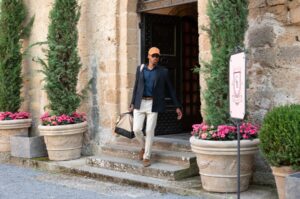The Everyday Lives of Women’s Clothing


Colorful house coats, waitress uniforms, a corsage made from sugar cubes, a can of shoulder pads. These and many other items offer a peek into personal closets across eras in the exhibition Real Clothes, Real Lives: 200 Years of What Women Wore at the New York Historical (formerly New-York Historical Society), and a book of the same name (2023, Rizzoli Electa). Sourced from the Smith College Historic Clothing Collection, a teaching archive dedicated to preserving everyday women’s clothing, the pieces on display span the late 1800s through nearly present day. Each article of clothing, from a work jacket with a tattered and patched lining (c. 1860s) to a shimmering azure blue Quinceañera dress (1982), tells the story of women’s lives in the United States at home and at work, during recreation and ritual.
To examine how clothing influences the wearers’ lives, and how their lives, in turn, influence their clothing, the exhibition pairs garments and accessories with archival photos and objects from the museum’s Center for Women’s History. Text placed on the clear Plexiglas display cases hovers over the garments and circles key construction details with helpful annotations, making it feel like you’re visiting with a knowledgeable friend who’s pointing out the most pertinent tidbits. The show is organized into sections dedicated to public and private dress, unpaid domestic labor and service jobs, protest and rebellion, and rites of passage.

Unlike the prevailing fashion exhibitions, which dazzle with runway looks and superstar designers, Real Clothes, Real Lives focuses on homemade or widely accessible apparel (for instance, Wrangler, Penney’s, and Lane Bryant) that has been really lived in. The curation frames the stains, tears, and mends not as flaws to hide or restore but as valuable clues into the life of the wearer. Though the show includes a smattering of pieces from celebrated figures, such as Sylvia Plath’s chambray Girl Scout uniform (1945) adorned with 20 round merit badges, most of the garb was worn by women who lived outside the spotlight. Relevant props bring to life the labor performed in the outfits: The hand of a mannequin donning a nurse uniform clasps a pill bottle, a handful of straws pokes out of the pocket of a waitress uniform.
A can-do, make-do spirit flashes through the exhibition. The turquoise morning wrapper (c. 1895), a comfortable garment worn indoors without bodice or petticoats, includes a fitted underbodice that could be adjusted to accommodate pregnancy and other bodily fluctuations. Whether sewing dresses with buttons rather than metal zippers to support World War II rationing efforts or buttoning early-20th-century skirts into “leg partitions” suitable for cycling, women have adapted their attire to accommodate their daily activities with resourcefulness and panache.

A show about women’s everyday clothing is inherently also about their bodies and tangible presence. Despite the Trump regime’s insistence on erasing the word “women” from government documents and public-facing websites, women, nonetheless, exist and persist. Our bodies grow and change, bear life or don’t, toil and rest, love and grieve, move and dance. There’s joy in picturing the woman in the ’80s lacing up her fire-engine-red high-heeled sneakers and matching Norma Kamali peplum suit for a night out, and a feeling of relatability in the snapshot of a bride noshing on a New York City hotdog after a city-hall wedding ceremony. Tenderness bubbles up while imagining the worker buttoning her navy blue polyester McDonald’s maternity uniform, a woman stretching the pale pink 1960s curler cap over a bouffant-to-be, or another sighing into the sofa after long day, plucking a needle from a hosiery mending kit to remedy yet another run. All these outfits in Real Clothes, Real Lives are embedded with memories, both from the wearer’s life and the associations and sartorial stories we bring to them as viewers.
In turning our attention to the ordinary, the exhibition, like the archive from which it was sourced, accomplishes something exceptional. It anchors us in the fabric of everyday survival and acts of ingenuity, revealing ways to adapt, mend, and reinvent — and look good, on our own terms, while doing it.









Real Clothes, Real Lives: 200 Years of What Women Wore continues at The New York Historical (170 Central Park West, Upper West Side, Manhattan) through June 22. The exhibition was curated by Rebecca Shea and Kiki Smith, along with Anna Danziger Halperin and Keren Ben-Horin.







